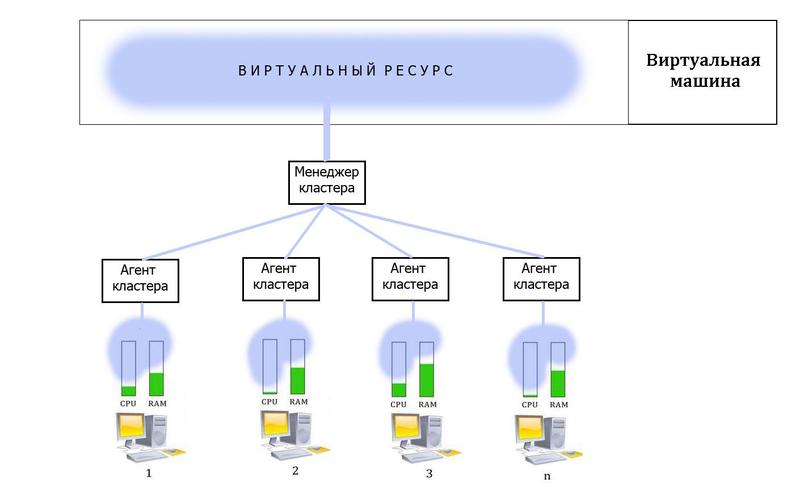Corporate Cluster. Thinking out loud
This post is a reflection on the most effective use of idle resources of the corporate network.
I will give the following example of a network of an average modern enterprise.
Given:
Corporate network consisting of 150 or more machines.
Each workstation has a “under the hood” processor with multiple cores, 2–4 GB DDRIII, SATAIII hard drive and a Gigabit Ethernet adapter (this configuration doesn’t surprise us anymore and is standard for an office computer. a big desire, buying a PC with more modest characteristics is not economically feasible).
Gigabit Ethernet network. There may be objections. Many work on the good old 5 categories for which an adequate ceiling is 100 Mbit / s. But again, new networks are more often built under 1000 Mbit / s.
Vinegret from software.
Local software: email client, text and table editors.
Client-server: client-bank, software for reporting, management and accounting.
Web software: workflow systems, portals, etc.
')
Not to be unsubstantiated, I decided to monitor the consumption of CPU and RAM resources on the workstations of my organization. The average percentage of resource usage of workstations during the day very rarely exceeds 25-30%. This is due to downtime during data collection by the user, viewing documents, reading information from the screen, printing, smoke breaks and interruptions. This is also due to the fact that web-based software and cloud services consume very few client-side resources.

Think:
Combine the resources of idle and under-active workstations and use them to solve the necessary computational problems. Preferably without compromising the efficiency of user workstations.
Now, actually, reflections:
Theoretically, we have a corporate cluster. It consists of all the machines in the enterprise network and uses their performance according to the established quota. The quota can be set on the basis of an anaziz data on the average workload of the system during the day / week / month ... Then the quota can be adjusted "on the fly" if the indicator of the average workload changes.

The weak point of all parallel computing systems is the communication channel between nodes (latency in processing and parallelizing tasks between nodes as well as overhead for synchronization). But at the moment, I repeat, more and more corporate networks are working at a speed of 1 Gbit / s, and this is good news.
Now, regarding the tasks solved by this cluster. The cluster itself, theoretically, can be an additional pool of resources for virtual machines, can provide a runtime environment for running resource-intensive tasks. The tasks of all are different and therefore this technology can be useful precisely due to its universality.
After I asked Google if anyone had dealt with this problem and found nothing, I decided to write about it in Habré. Let us, comrades, discuss whether it makes sense to develop this area or not.
I will give the following example of a network of an average modern enterprise.
Given:
Corporate network consisting of 150 or more machines.
Each workstation has a “under the hood” processor with multiple cores, 2–4 GB DDRIII, SATAIII hard drive and a Gigabit Ethernet adapter (this configuration doesn’t surprise us anymore and is standard for an office computer. a big desire, buying a PC with more modest characteristics is not economically feasible).
Gigabit Ethernet network. There may be objections. Many work on the good old 5 categories for which an adequate ceiling is 100 Mbit / s. But again, new networks are more often built under 1000 Mbit / s.
Vinegret from software.
Local software: email client, text and table editors.
Client-server: client-bank, software for reporting, management and accounting.
Web software: workflow systems, portals, etc.
')
Not to be unsubstantiated, I decided to monitor the consumption of CPU and RAM resources on the workstations of my organization. The average percentage of resource usage of workstations during the day very rarely exceeds 25-30%. This is due to downtime during data collection by the user, viewing documents, reading information from the screen, printing, smoke breaks and interruptions. This is also due to the fact that web-based software and cloud services consume very few client-side resources.

Think:
Combine the resources of idle and under-active workstations and use them to solve the necessary computational problems. Preferably without compromising the efficiency of user workstations.
Now, actually, reflections:
Theoretically, we have a corporate cluster. It consists of all the machines in the enterprise network and uses their performance according to the established quota. The quota can be set on the basis of an anaziz data on the average workload of the system during the day / week / month ... Then the quota can be adjusted "on the fly" if the indicator of the average workload changes.

The weak point of all parallel computing systems is the communication channel between nodes (latency in processing and parallelizing tasks between nodes as well as overhead for synchronization). But at the moment, I repeat, more and more corporate networks are working at a speed of 1 Gbit / s, and this is good news.
Now, regarding the tasks solved by this cluster. The cluster itself, theoretically, can be an additional pool of resources for virtual machines, can provide a runtime environment for running resource-intensive tasks. The tasks of all are different and therefore this technology can be useful precisely due to its universality.
After I asked Google if anyone had dealt with this problem and found nothing, I decided to write about it in Habré. Let us, comrades, discuss whether it makes sense to develop this area or not.
Source: https://habr.com/ru/post/179725/
All Articles